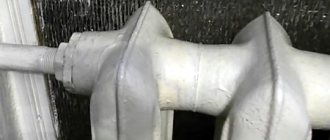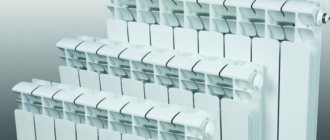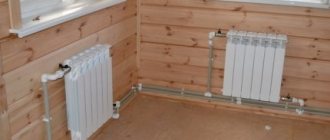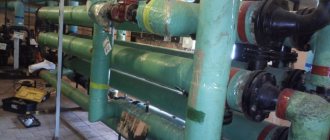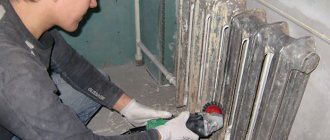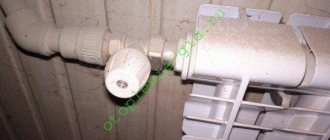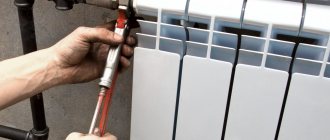The battery needs not only external, but also internal flushing.
Any heating battery will heat your living space worse and worse over time. The reason for this is its gradual contamination from the inside. It is also greatly facilitated by the coolant, which, when circulating through the general system, brings “foreign” contaminants into your radiator. How to flush a heating battery to return it to its previous useful volume of heat? We will tell you about the features of both external and internal cleaning.
Which batteries need to be washed?
All types of batteries require cleaning:
- Cast iron coolants often become clogged due to infrequent cleaning.
- A layer of rust settles in steel batteries, which significantly narrows the clearance for water passage and gradually corrodes the system.
- Plastic coolants also need care. The principles of washing plastic are slightly different from cleaning other types of coolants.
It's time to wash the batteries if:
- The radiator takes too long to warm up.
- The coolant segments are heated unevenly.
- Strange sounds during operation.
- Cold radiator (compared to the temperature of the central battery).
Poor performance of the coolant may also be caused by the formation of an air lock, to eliminate which it is enough to bleed air through the tap. If these measures are not successful, flushing the radiator of the heating system is required.
Briefly about the main thing
To maintain the efficiency of heating quality, a number of rules must be followed:
- Avoid using unprepared liquid as a coolant. In its simplest form, preparation involves boiling. This way the amount of salts is significantly reduced. But it is more effective to purchase specially created inhibitors that reduce the activity of corrosive processes. When choosing them, you need to make sure that the composition and material of the surfaces match.
- Know when heating systems are flushed and strictly follow the main steps.
- Coarse filters must be installed on heating lines. They are mounted in such a way that the pipe faces down. This will make it easier to clean, since all dirt is drained simultaneously with water.
- When choosing a contractor company, pay attention to companies that provide a guarantee for the activities carried out.
The heating system is cleaned by the company's professional staff within one day. Therefore, you should not neglect this service. The result will be a constant comfortable temperature in all rooms, as well as significant savings on heating.
Mechanical flushing of coolant
Mechanical flushing is carried out by disassembling the heating elements. Dirt and deposits are effectively removed, but this method will not help against scale and corrosion. To carry out cleaning, the batteries are closed, removed, and the water is drained from the pipes.
The radiator is placed in the bathroom, having previously covered it with a cloth and closed the drain hole. Washing is done under a powerful stream of water.
Chemical battery flush
Chemical washing is carried out by pouring chemical reagents into the coolant. Flushing the heating radiator in an apartment is most often done using special mixtures. The method is effective and inexpensive.
- Flushing with a chemical composition is carried out both in summer and winter without stopping the main heating.
- Reagents remove rust and salt deposits. The composition of the chemical solution is selected taking into account the category of the radiator.
- The technicians shut off the battery, pump the chemical composition into the radiator, wait for the time allotted in the instructions, and then simply drain the liquid through the tap.
If the system is not pressed in, baking soda, whey, phosphoric and acetic acids are used for cleaning. The liquid for flushing heating radiators can be either alkaline or acidic.
When choosing a reagent, it is important to correctly calculate the time it remains inside the coolant to avoid damage to the battery. Chemical flushing is not suitable for aluminum radiators.
How to wash a battery at home: step-by-step instructions
Cleaning heating elements every year to improve energy efficiency can be a daunting task. Not every owner will want to understand how to wash a radiator. This is not only because of laziness, but also the risks of “getting things done” that are fraught with material damage. In such cases, a detailed guide will not be superfluous. If the recommendations are strictly followed, serious incidents are excluded. So, you need to consider the following:
- Cleaning your heating system requires proper preparation. Make sure you buy a tool that will make the job easier. It is worth getting a special brush, a piece of metal wire, and preparing a hammer and screwdriver.
- Dismantling is carried out with maximum meticulousness. If the heating system is centralized and connected, close the valve and wait until the radiator cools down. Place a basin under the heating element, and then carefully unscrew the air intake valve. Be careful not to let water get on the floor or wall. First, compressed air will come out of the heater along with a small amount of water. If the liquid flows in a calm stream, everything is in order and you can soon begin dismantling.
- After draining the radiator, check the faucet to make sure no water is leaking out. Clean using one of the selected methods.
- Turn off the tap and fill the radiator to ⅔ capacity. Next, gradually reduce the flow pressure. This is necessary in order to safely displace the air at the top of the plate. The radiator air intake can be adjusted using a screwdriver or wrench.
Please note : the system may be powered by a hydraulic pump. In this case, those who want to figure out how to clean radiators inside need to be more careful when opening and closing any tap.
Plate bimetallic radiators are aesthetically pleasing and fit well into the interior. Any pipe that is supplied to them can be connected in a matter of minutes. But eliminating the accumulation of contaminants will be more difficult. Flushing a heating battery is another challenge. The work not only requires skill, but also involves the use of a specific tool. Although if you are prepared, such an activity will not seem fleeting.
For housewives: How to clean a bathtub: 5 types of dirt and how to remove them
Dispersed battery washing
Dispersed washing has a high-molecular effect on rust and other deposits. The solutions are harmless to people and metal elements.
Dirt, crushed into small pieces, is discharged through the drain, so pieces of dirt do not clog the radiator. After completing the treatment of the battery, a film is formed inside the pipes, preventing the accumulation of lime on the walls of the battery.
Washing is carried out as follows:
- Calculation of reagents is carried out.
- The radiator is being prepared.
- The coolant is connected to a pump, which will help introduce liquid into the system.
- Wait time (depending on the degree of clogging of the system and the choice of reagent).
- The waste liquid is drained into the sewer.
- Cleaning takes place in several stages.
Hydrodynamic battery cleaning
Thin streams of water under pressure of several atmospheres are supplied to the system using a pump and hose nozzles. It is impossible to carry out hydrodynamic cleaning of batteries without special equipment: the help of specialists is required.
However, this method is the most environmentally friendly and most effective for cast iron.
The price for flushing heating radiators is very high, since at the initial stage the deposits are softened with a chemical composition, and only then the pipes are cleaned with a pump.
Hydropneumatic battery cleaning
The heating circuit is purged by a powerful compressor. Build-ups and deposits under the influence of high pressure are torn off the walls of the battery and washed out through a hose lowered into the sewer.
Flushing a heating radiator without removing it is a convenient and effective way to clean the coolant. Washing takes only a few minutes. Pulse impacts are carried out in several stages with short intervals, destroying deposits and bringing them out.
Tools for disassembling a cast iron device
Their list consists of:
- Radiator key.
- Chisels.
- Hammer.
- A small sledgehammer.
- Brushes with metal bristles.
- Blowtorch.
- Plumbing wrench No. 2,3. They need to unscrew the side plugs or plugs.
In many cases there is no radiator key. The situation is complicated by the fact that it is almost impossible to find in construction stores. Of course, it exists in the markets. Also, plumbers must have such a key.
The key itself is a round metal bar. which is 18 mm in diameter. One end is flattened and resembles a spatula. It has dimensions 28x40 mm. Thickness 6 mm. At the other end there is a welded ring. You need to insert a lever into it. As for the length of the key, it should exceed half the length of the radiator by 30 cm.
You also need to prepare several boards. Chocks may be suitable instead. They will be fitted with a battery before disassembly.
Electrohydropulse technique for washing batteries
During flushing, electrical pulse energy is used to destroy salts and rust inside the pipes.
- It is possible to carry out electrohydropulse cleaning of batteries without removing the elements.
- At the end of the process, the coolant is washed with ordinary water for final cleaning of contaminants.
The method is suitable for batteries of any configuration. The system allows the batteries to return to the factory pipe cross-section, since all deposits are removed almost completely.
Causes of dirt
In centralized heating systems it is difficult to check the quality of the coolant. Various foreign impurities are found in the water circulating through the network. Therefore, heat pipelines also need to be monitored and maintained in proper condition. There are often areas where pipes have been standing for 10 years, or even more. And during this entire period, corrosion processes occur in the system.
Hot water is supplied under pressure, breaking off pieces of rust from the inner surface of the pipes. It is these elements that then go to the radiators, where they settle on the walls.
Thus, the channels of heating devices become clogged with impurities, debris and rust during their service life. This leads to a decrease in the amount of coolant that can pass inside the pipes. As a result, the heating efficiency deteriorates. And even if the coolant heats up to high temperatures, this will not change the situation much.
Self-flushing of coolant
Experts recommend washing the batteries in the house before the start of the heating season, but after purging the circuit. Otherwise, dirt from other radiators will quickly enter the battery from other apartments. It is enough to clean radiators once every 3 years.
It is recommended to clean cast iron batteries only after the end of the heating season, since the material is very sensitive to temperature changes.
In a private house where water for heating is taken from wells, it is necessary to clean the circuit. It is enough to turn off the boiler and bleed air from the system. A radiator flushing method is selected that is suitable for the type of battery, and the entire heating system is cleaned.
At home, to increase efficiency, it is recommended to use special reagents. The battery is removed, placed in the bathroom, washed with running water, shaking and tapping the walls.
The largest particles of deposits come out after the first wash. Then, for several hours, chemicals are poured into the heating element, which can almost always be found in the house:
- Hydrogen peroxide (cleans and disinfects pipes). To clean, peroxide is poured directly into the pipe;
- Citric acid (eliminates odors). Prepare a solution of 3 tsp. per glass of water;
- Baking soda (2 tbsp per 3 liters of water).
Flushing heating radiators is a technically simple process that can be done at home. However, you can always turn to specialists.
Frequency of cleaning the heating system
Poor heating of the batteries and extraneous sounds during their operation are the most common signals about the need to clean the pipelines. The frequency of this procedure depends on the following factors:
- temperatures during system operation;
- composition of the liquid flowing through the system;
- battery materials;
- pipeline materials.
The first cleaning is carried out immediately after the installation work on the pipeline and radiators. Further, the frequency of flushing the heating system, according to the standards, is as follows:
- for PVC products once a year before starting the boiler;
- for iron products - before and after the operation of pipes and radiators.
The choice of cleaning option depends on the materials used, as well as the overall operating period of the heating devices. Proper flushing of the heating system, regulatory documents and procedure are specified in SNiP 3.05.01-85.
Timely cleaning of pipes will preserve the integrity of individual elements of the system Source ytimg.com
